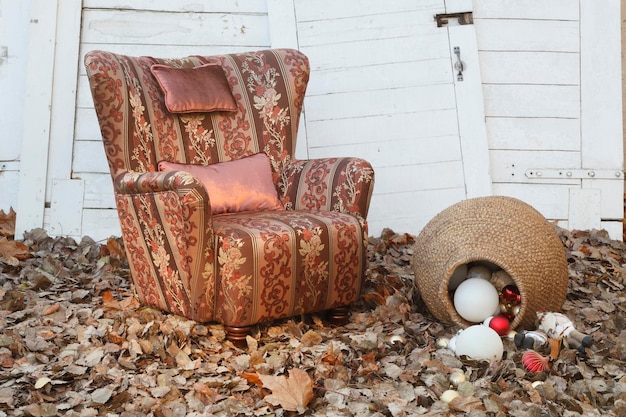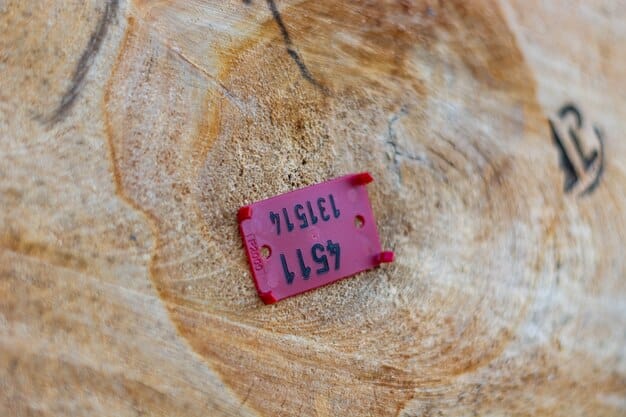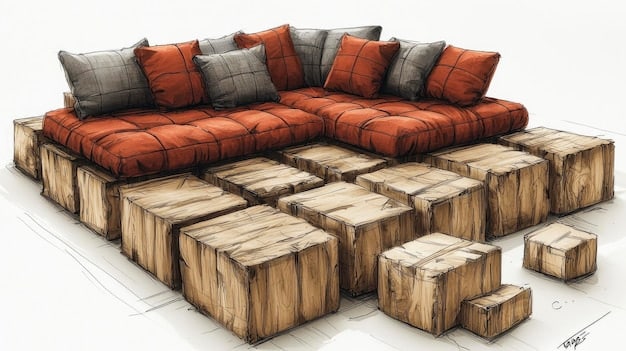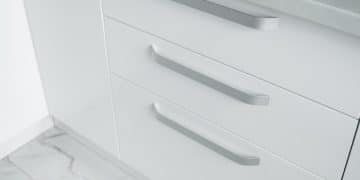Upcycle Old Pallets: Stylish Outdoor Furniture Project for 2025

Upcycle old pallets into stylish outdoor furniture for a sustainable and budget-friendly 2025, transforming discarded materials into unique, functional pieces with a weekend DIY project.
Ready to transform your outdoor space with unique, budget-friendly furniture? **Upcycle old pallets into stylish outdoor furniture: A Weekend Project for 2025** is the perfect solution for adding character and sustainability to your patio or garden.
Finding and Selecting the Right Pallets for Your Project
Embarking on a DIY pallet furniture project begins with sourcing suitable pallets. Not all pallets are created equal, and selecting the right ones is crucial for both safety and aesthetic appeal. Understanding the different types of pallets and how to identify safe options will set you up for success.
Identifying Safe Pallets
Look for pallets marked with an IPPC (International Plant Protection Convention) stamp. This indicates that the pallet has been treated to prevent the spread of pests and diseases. The most common treatments are heat treatment (HT) and kiln drying (KD), which are generally safe. Avoid pallets marked with “MB” (methyl bromide), as this is a toxic fumigant.
Where to Find Pallets
Many businesses discard pallets regularly, making them a readily available resource. Here are some places to check:
- Local Businesses: Check with small businesses, retail stores, and warehouses in your area. They often have pallets they are willing to give away.
- Construction Sites: Construction sites frequently have surplus pallets. However, always ask for permission before taking any.
- Online Marketplaces: Platforms like Craigslist or Facebook Marketplace often have listings for free or inexpensive pallets.
- Recycling Centers: Some recycling centers collect and redistribute pallets.
Once you’ve identified potential sources, thoroughly inspect each pallet for damage, mold, or chemical stains. Choose pallets that are in good condition, free from splinters and excessive wear.

Selecting the right pallets is the foundation for a successful and safe DIY furniture project. By knowing what to look for and where to find them, you can ensure your project starts on the right foot.
Essential Tools and Materials for Pallet Furniture Construction
Before diving into your pallet furniture project, gather all the necessary tools and materials. Having everything on hand will streamline the construction process and ensure a smooth, efficient experience. This section outlines the essential items you’ll need to transform old pallets into stylish outdoor furniture.
Tools You’ll Need
A well-equipped toolkit is essential for any DIY project. Here’s a list of tools that will be particularly useful for working with pallets:
- Safety Glasses: Protect your eyes from flying debris.
- Gloves: Protect your hands from splinters and rough wood.
- Crowbar and Hammer: For disassembling pallets.
- Sander or Sandpaper: To smooth rough edges and surfaces.
- Circular Saw or Hand Saw: For cutting pallets to size.
- Drill with Screwdriver Bits: For assembling furniture pieces.
- Measuring Tape: For accurate measurements and planning.
- Level: To ensure your furniture is stable and even.
Materials Required
In addition to tools, you’ll need various materials to complete your pallet furniture project:
- Screws and Nails: For securely joining pallet pieces.
- Wood Glue: For added strength and stability.
- Wood Sealant or Stain: To protect the wood from the elements.
- Paint or Varnish: To add color and finish.
- Cushions and Fabric: For comfort and style (optional).
- Sandpaper: For smoothing surfaces.
With the right tools and materials, you’ll be well-prepared to tackle your pallet furniture project. Careful preparation ensures a smoother, safer, and more enjoyable DIY experience.
Designing Your Pallet Furniture: From Concept to Creation
The design phase is critical in ensuring your upcycled pallet furniture not only looks great but also meets your specific needs. This section guides you through the process of conceptualizing your furniture, creating a plan, and selecting designs that maximize both functionality and aesthetic appeal.
Conceptualizing Your Furniture
Start by considering what kind of outdoor furniture you need. Do you want a comfortable lounge set, a dining table, or a unique planter? Sketch out your ideas and think about the dimensions that would best fit your space.
Creating a Plan
Once you have a concept, create a detailed plan. This involves measuring your pallets, determining how to cut and assemble them, and noting any additional materials you’ll need. A well-thought-out plan will save you time and prevent mistakes during the construction phase.
Design Ideas for Pallet Furniture
Here are a few design ideas to inspire your pallet furniture project:
- Pallet Sofa: Construct a comfortable sofa by stacking pallets and adding cushions.
- Pallet Coffee Table: Create a rustic coffee table by attaching legs to a pallet.
- Pallet Adirondack Chairs: Build classic Adirondack chairs with a unique pallet twist.
- Pallet Planters: Design vertical or horizontal planters to showcase your favorite plants.

Designing your pallet furniture is an exciting step where your creativity can shine. By carefully planning and considering different designs, you can create unique and functional pieces that perfectly complement your outdoor space.
Step-by-Step Guide to Assembling Pallet Outdoor Furniture
With your design in hand and materials ready, it’s time to assemble your pallet outdoor furniture. This section provides a step-by-step guide to help you construct a basic pallet sofa, offering clear instructions and tips for a successful build.
Step 1: Prepare the Pallets
Begin by cleaning the pallets thoroughly. Remove any dirt, debris, or loose nails. Sand the surfaces to smooth out rough edges and splinters. Apply a wood sealant or stain to protect the wood from the elements.
Step 2: Assemble the Base
Stack the pallets to create the desired height for your sofa base. Secure the pallets together using screws and wood glue. Ensure the base is stable and level.
Step 3: Create the Backrest
Disassemble another pallet and use the planks to create a backrest. Attach the planks to the back of the base, ensuring they are securely fastened. Angle the backrest slightly for added comfort.
Step 4: Add Finishing Touches
Fill any nail holes or gaps with wood filler. Sand the entire sofa to ensure a smooth finish. Apply a coat of paint or varnish to protect the wood and enhance its appearance.
Step 5: Add Cushions and Decor
Place comfortable cushions and pillows on the sofa to complete the look. Add outdoor rugs, string lights, and plants to create a cozy and inviting outdoor living space.
Following these steps will guide you through the process of assembling your pallet outdoor furniture. With patience and attention to detail, you’ll create a beautiful and functional piece that adds character to your outdoor space.
Finishing and Protecting Your Pallet Furniture
Once your pallet furniture is assembled, the finishing touches are crucial for ensuring its durability and aesthetic appeal. This section covers the best practices for sanding, painting, sealing, and weatherproofing your upcycled creations.
Sanding for a Smooth Finish
Sanding is essential for removing rough edges and splinters. Start with a coarse-grit sandpaper to smooth the surface, then move to a finer grit for a polished finish. Pay special attention to areas that will be in direct contact with skin.
Painting and Staining
Choose a paint or stain that complements your outdoor decor. Apply multiple thin coats for even coverage and allow each coat to dry completely before applying the next. Consider using outdoor-rated paints and stains for added protection against the elements.
Sealing for Weather Resistance
Sealing your pallet furniture is vital for protecting it from moisture, sun, and other environmental factors. Apply a high-quality wood sealant to all surfaces, paying particular attention to joints and edges. Reapply sealant annually to maintain its protective properties.
Weatherproofing Tips
Here are some additional tips for weatherproofing your pallet furniture:
- Use Outdoor Fabrics: Choose cushions and fabrics that are designed for outdoor use.
- Cover During Inclement Weather: Protect your furniture with covers during rain, snow, or extreme sun.
- Elevate Furniture: Place your furniture on blocks or risers to prevent direct contact with the ground.
Proper finishing and protection will extend the life of your pallet furniture, keeping it looking beautiful and functional for years to come. Regular maintenance and care are key to enjoying your upcycled creations for the long term.
Maintaining and Caring for Your Pallet Furniture
To ensure your upcycled pallet furniture remains stylish and functional for years to come, regular maintenance and care are essential. This section provides practical tips for cleaning, repairing, and seasonal upkeep to keep your outdoor pieces in top condition.
Regular Cleaning
Regular cleaning helps prevent the buildup of dirt, mold, and mildew. Use a mild soap and water solution to wipe down your pallet furniture. For stubborn stains, a soft-bristled brush may be necessary. Rinse thoroughly and allow to dry completely.
Repairing Damage
Inspect your pallet furniture regularly for signs of damage, such as loose screws, cracked wood, or peeling paint. Tighten screws, replace damaged wood, and touch up paint as needed. Addressing minor repairs promptly will prevent them from becoming major issues.
Seasonal Upkeep
As the seasons change, adjust your maintenance routine accordingly:
- Spring: Inspect for winter damage and apply a fresh coat of sealant or paint.
- Summer: Clean regularly to remove dirt and grime accumulated during outdoor use.
- Fall: Prepare for colder weather by covering or storing your furniture.
- Winter: Store furniture indoors or cover it securely to protect it from snow and ice.
By following these maintenance and care tips, you can ensure your pallet furniture remains a stylish and functional part of your outdoor space for many years.
| Key Point | Brief Description |
|---|---|
| 🔨 Finding Pallets | Check local businesses, construction sites, and online marketplaces. |
| 🛠️ Essential Tools | Gather tools like a crowbar, sander, saw, drill, and measuring tape. |
| 🎨 Finishing Touches | Sand, paint, and seal your pallet furniture for weather resistance. |
| 🧽 Regular Maintenance | Clean and repair regularly to keep your furniture in top condition. |
FAQ
▼
No, not all pallets are safe. Avoid those marked with “MB” (methyl bromide) as they have been treated with a toxic fumigant. Look for pallets marked with “HT” (heat treated) or “KD” (kiln dried), which are safer options.
▼
You can find free pallets at local businesses, construction sites, and online marketplaces like Craigslist or Facebook Marketplace. Always ask for permission before taking pallets from private property.
▼
Essential tools include safety glasses, gloves, a crowbar, hammer, sander, circular saw, drill, measuring tape, and level. Having these tools will make the project smoother and safer.
▼
Protect your pallet furniture by using outdoor-rated paints and stains, applying a high-quality wood sealant, and covering the furniture during inclement weather. Elevating the furniture can also help.
▼
Regular maintenance is key. Clean your pallet furniture every few weeks and inspect it seasonally for any damage. Reapply sealant annually to ensure continuous protection from the elements.
Conclusion
Transforming old pallets into stylish outdoor furniture is a rewarding DIY project that combines sustainability with creativity. By following these guidelines, you can create unique, functional, and cost-effective pieces that enhance your outdoor living space for 2025 and beyond.




